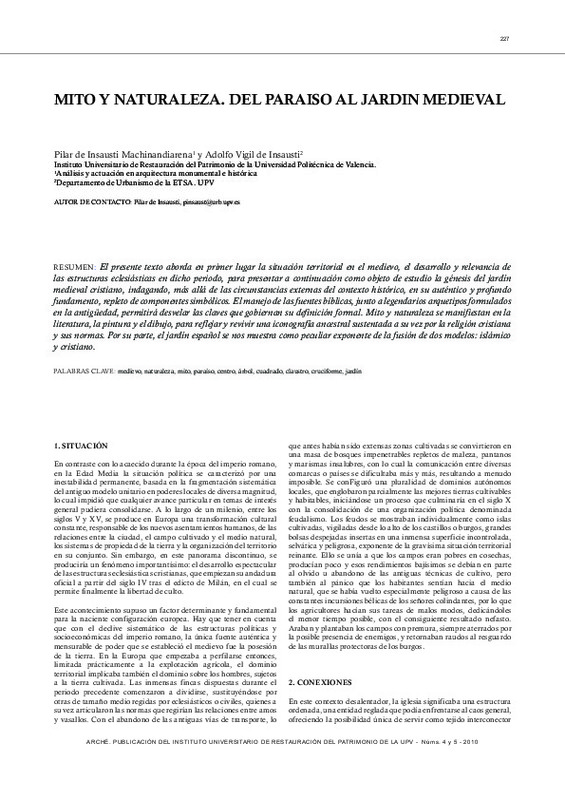JavaScript is disabled for your browser. Some features of this site may not work without it.
Buscar en RiuNet
Listar
Mi cuenta
Estadísticas
Ayuda RiuNet
Admin. UPV
Mito y naturaleza. Del paraíso al jardín medieval
Mostrar el registro sencillo del ítem
Ficheros en el ítem
| dc.contributor.author | Insausti Machinandiarena, Pilar
|
es_ES |
| dc.contributor.author | Vigil De Insausti, Adolfo
|
es_ES |
| dc.date.accessioned | 2013-07-12T08:56:17Z | |
| dc.date.available | 2013-07-12T08:56:17Z | |
| dc.date.issued | 2010 | |
| dc.identifier.issn | 1887-3960 | |
| dc.identifier.uri | http://hdl.handle.net/10251/31072 | |
| dc.description.abstract | El presente texto aborda en primer lugar la situación territorial en el medievo, el desarrollo y relevancia de las estructuras eclesiásticas en dicho periodo, para presentar a continuación como objeto de estudio la génesis del jardín medieval cristiano, indagando, más allá de las circunstancias externas del contexto histórico, en su auténtico y profundo fundamento, repleto de componentes simbólicos. El manejo de las fuentes bíblicas, junto a legendarios arquetipos formulados en la antigüedad, permitirá desvelar las claves que gobiernan su definición formal. Mito y naturaleza se manifiestan en la literatura, la pintura y el dibujo, para reflejar y revivir una iconografía ancestral sustentada a su vez por la religión cristiana y sus normas. Por su parte, el jardín español se nos muestra como peculiar exponente de la fusión de dos modelos: islámico y cristiano. | es_ES |
| dc.description.abstract | This text first of all tackles the territorial situation in the Middle Ages, the development and relevance of ecclesiastical structures in this period. It then goes on to present its subject, the genesis of the Christian medieval garden, investigating, beyond the external circumstances of the historical context, its genuine in-depth foundation, full of symbolic elements. The treatment of biblical sources, along with legendary archetypes developed in ancient times, will enable the keys governing its formal definition to be revealed. Myth and nature come forward in literature, painting and drawing, to reflect and bring back to life an ancestral iconography, in turn sustained by the Christian religion and its rules. The Spanish garden comes forward as a peculiar example of a blend of two models: Islamic and Christian. | es_ES |
| dc.format.extent | 10 | es_ES |
| dc.language | Español | es_ES |
| dc.publisher | Instituto Universitario de Restauración del Patrimonio de la UPV | es_ES |
| dc.relation.ispartof | Arché | es_ES |
| dc.rights | Reserva de todos los derechos | es_ES |
| dc.subject | Medievo | es_ES |
| dc.subject | Naturaleza | es_ES |
| dc.subject | Mito | es_ES |
| dc.subject | Paraíso | es_ES |
| dc.subject | Árbol | es_ES |
| dc.subject | Cuadrado | es_ES |
| dc.subject | Claustro | es_ES |
| dc.subject | Cruciforme | es_ES |
| dc.subject | Jardín | es_ES |
| dc.subject | Middle Ages | es_ES |
| dc.subject | Nature | es_ES |
| dc.subject | Myth | es_ES |
| dc.subject | Paradise | es_ES |
| dc.subject | Centre | es_ES |
| dc.subject | Tree | es_ES |
| dc.subject | Square | es_ES |
| dc.subject | Cloister | es_ES |
| dc.subject | Cruciform | es_ES |
| dc.subject | Garden | es_ES |
| dc.subject.classification | CONSERVACION Y RESTAURACION DE BIENES CULTURALES (UPV) | es_ES |
| dc.title | Mito y naturaleza. Del paraíso al jardín medieval | es_ES |
| dc.title.alternative | Myth and nature: from paradise to the medieval garden | es_ES |
| dc.type | Artículo | es_ES |
| dc.rights.accessRights | Abierto | es_ES |
| dc.contributor.affiliation | Universitat Politècnica de València. Instituto Universitario de Restauración del Patrimonio - Institut Universitari de Restauració del Patrimoni | es_ES |
| dc.description.bibliographicCitation | Insausti Machinandiarena, P.; Vigil De Insausti, A. (2010). Mito y naturaleza. Del paraíso al jardín medieval. Arché. (4-5):227-236. http://hdl.handle.net/10251/31072 | es_ES |
| dc.description.upvformatpinicio | 227 | es_ES |
| dc.description.upvformatpfin | 236 | es_ES |
| dc.description.issue | 4-5 | |
| dc.identifier.eissn | 2445-1150 |






